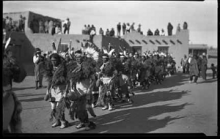Article
In many Native American cultures, dancing is a common part of spiritual, communal ceremonies. Dancing can be a form of supplication to spirits or deities, for purposes that includes seasonal festivities, celebratory events, healing rituals, or the blessing of certain feats such as important battles or hunting trips. While dance is a common practice among various Native American groups, the form these dances take changes between cultures, as do traditions regarding who is permitted to perform them.
Among the Pueblo peoples of the Southwest, some of the most common dances are the masked kachina dances. Kachinas are guardian spirits, often associated with dead ancestors, who are believed to reside in a separate but parallel realm. According to traditional lore, kachinas return to the pueblo villages during special ceremonies. Ritual dances, in which the dancers don sacred kachina masks and embody the kachina spirit, are performed in order to invite and please the spirits. The dances often involve offerings and reverence for which the kachinas, in return, would guarantee protection and sustenance for the community, especially through bringing the rains needed for raising crops. In Puebloan cultures, both men and women can participate in ceremonial dances, although women are often excluded from surrounding spiritual practices, such as kiva societies' gatherings. Little boys who are initiated into kiva societies are often taught the dances before they have a chance to even learn the prayers.
"Cloud Dance, Santa Clara Pueblo, New Mexico," photograph by Parkhurst, T. Harmon. T. Harmon Parkhurst Photo Collection ( 003903) Palace of the Governors Photo Archive, New Mexico History Museum, Santa Fe
Manuscripts
A03 The Boy Who Made Dragonfly (06-08) p. 23
A03 The Boy Who Made Dragonfly (06-08) p. 26
A03 The Boy Who Made Dragonfly (06-08) p. 36
A03 The Boy Who Made Dragonfly (06-08) p. 41
References
Bradfield, Maitland
1973 Natural History of Associations: A Study in the Meaning of Community. New York:
International Universities Press.
Bunzel, Ruth Leah
1932 Introduction To Zuñi Ceremonialism. 47Th Annual Report of the Bureau of American
Ethnology. Washington: U. S. Government Printing Office.
Dennis, Wayne
1940 Hopi Child. New York: D. Appleton-Century Company, Incorporated, for the Institute
for Research in the Social Sciences, University of Virginia.
Kennard, Edward Allan and Edwin Earle
1971 Hopi Kachinas. New York: Museum of the American Indian, Heye Foundation.
Reichard, Gladys Amanda
1950 Navaho Religion: A Study of Symbolism. New York: Bollinger Foundation.
Reichard, Gladys Amanda
1928 Social Life of the Navajo Indians: With Some Attention to Minor Ceremonies.
Columbia University Contributions to Anthropology. New York: Columbia University Press.
Stevenson, Matilda Coxe Evans
1904 Zuni Indians: Their Mythology, Esoteric Fraternities, and Ceremonies. U.S. Bureau of
American Ethnology. Twenty-Third Annual Report. 1901-1902. Washington: Government
Printing Office.

